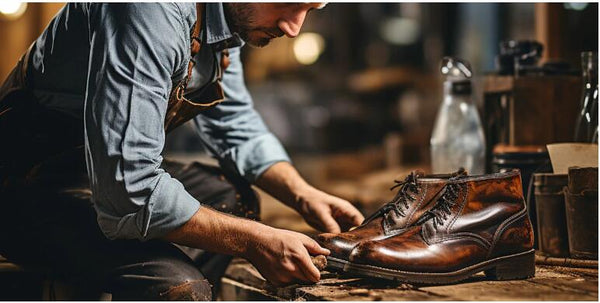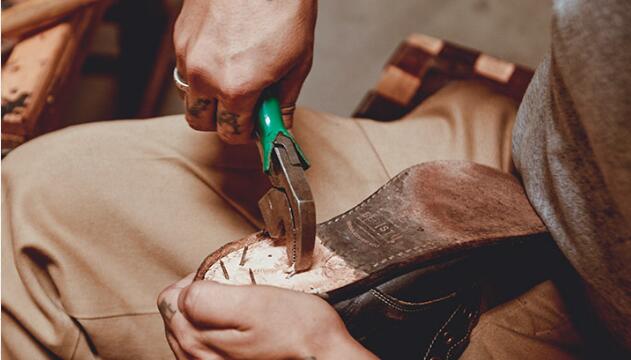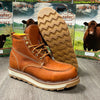Your cart is currently empty
Rescuing Leather: Effective Tips and Tricks for Gum Removal
Leather, with its timeless allure and enduring strength, holds a cherished place in the hearts of many. Yet, even the most adored leather possessions can fall victim to an unexpected adversary: chewing gum. Sticky and unyielding, gum has the power to transform your beloved leather into an unsightly mess.
Yet, there's no need for despair; we're here to provide you with effective techniques and insider wisdom for liberating your leather from the clutches of gum. We will walk you through proven tips and tricks to ensure your leather possessions are restored to their pristine glory.
1. The Freezer Method
1.1. One of the simplest and most effective methods for removing gum from leather is the freezer method. Here's how to do it:
1.2. Gather Your Supplies: You'll need a plastic bag (like a Ziploc), a piece of ice or an ice pack, and a butter knife or a similar dull-edged tool.
1.3. Freeze the Gum: Place the ice or ice pack in the plastic bag. Make sure the bag is sealed to prevent any moisture from leaking onto the leather.
1.4. Apply the Cold: Gently press the cold bag against the gum for about 15-20 minutes. This will harden the gum, making it less sticky and easier to remove.
1.5. Scrape It Off: After freezing, use the dull-edged tool (like a butter knife) to gently scrape off the gum. Be careful not to scratch the leather.
1.6. Clean and Condition: Once the gum is removed, clean the leather with a leather cleaner and then apply a leather conditioner to restore its luster and suppleness.
2. The Vinegar Method
Vinegar is a versatile household item that can help break down the stickiness of gum. Here's how to use it:
2.1. Prepare a Vinegar Solution: Mix equal parts of white vinegar and water in a bowl.
2.2. Dampen a Cloth: Soak a clean cloth or sponge in the vinegar solution, ensuring it's not soaking wet but damp.
2.3. Apply to the Gum: Place the damp cloth over the gum for about 10-15 minutes. This will help soften the gum.
2.4. Scrape Gently: Use a plastic scraper or a credit card to gently lift the gum off the leather. Be patient and avoid using excessive force to prevent damage.
2.5. Clean and Condition: Wipe the area with a clean, damp cloth to remove any vinegar residue. Then, follow up with a leather cleaner and conditioner to restore the leather's finish.
3. The Peanut Butter Method
Believe it or not, peanut butter can be a surprising ally in the battle against gum. Here's how to use it:
3.1. Choose Creamy Peanut Butter: Opt for creamy peanut butter rather than chunky.
3.2. Apply a Thin Layer: Spread a thin layer of peanut butter over the gum-affected area.
3.3. Let It Sit: Allow the peanut butter to sit on the gum for about 10-15 minutes. The oils in the peanut butter will help break down the gum's stickiness.
3.4. Gently Remove: Using a plastic scraper or a credit card, gently lift the gum from the leather. Be patient and avoid vigorous scraping.
3.5. Clean and Condition: Wipe away any peanut butter residue with a clean, damp cloth. Then, clean and condition the leather to maintain its quality.
4. The Rubbing Alcohol Method
Rubbing alcohol can effectively dissolve gum without harming your leather. Here's how to use it:
4.1. Gather Your Supplies: You'll need a cotton ball or clean cloth and some rubbing alcohol (isopropyl alcohol).
4.2. Apply the Alcohol: Soak the cotton ball or cloth with rubbing alcohol.
4.3. Dab the Gum: Gently dab the gum with the alcohol-soaked cotton ball. Avoid excessive rubbing.
4.4. Lift the Gum: After a few minutes, use a plastic scraper or a credit card to gently lift the gum off the leather.
4.5. Clean and Condition: Wipe away any remaining alcohol with a clean, damp cloth. Follow up with a leather cleaner and conditioner to maintain the leather's integrity.
Prevent Future Gum Mishaps
Now that you've successfully rescued your leather from gum, it's time to consider preventive measures:
- Be Mindful: Avoid placing gum or sticky items near your leather belongings.
- Regular Cleaning: Clean your leather items regularly with a leather cleaner and conditioner to maintain their quality and make them less sticky-prone.
- Storage: Store your leather items properly in a cool, dry place to prevent exposure to extreme temperatures and humidity, which can make gum removal more challenging.
With these effective gum removal methods and preventive tips, your leather items can continue to shine in all their glory, gum-free and gorgeous.

Understanding Why Gum Clings to Leather
Before we jump into the removal process, it's essential to understand why gum sticks to leather in the first place. Gum is a sticky substance that contains polymers and additives, which give it its adhesive properties. When gum comes into contact with leather, several factors contribute to its adhesion:
- Texture: Leather has a porous surface with natural textures and grain patterns. These tiny pores and imperfections provide a perfect surface for gum to cling to.
- Temperature: Gum tends to harden and become stickier in colder temperatures. If you've accidentally sat on gum or placed your leather item in a chilly environment, the gum is more likely to bond with the leather.
- Pressure and Friction: Applying pressure or friction to gum can cause it to spread and embed itself further into the leather's texture. For instance, sitting on gum or rubbing it inadvertently increases the adhesion.
Now that we understand why gum sticks to leather let's explore the tools and supplies you'll need to remove it effectively.
How To Get Gum Off Leather Seats
Removing gum from leather car seats can be a bit tricky, but with patience and the right approach, you can do it effectively without damaging the leather. Here's a step-by-step guide on how to get gum off leather seats:
- Step 1: Prepare the materials you need.
Materials You'll Need:
Mild leather cleaner or leather-specific cleaning solution
Clean, soft white cloth or microfiber towel
Water
Leather conditioner (optional)
- Step 2: Scrape off the Gum
Use a plastic scraper: After freezing, take a plastic scraper or a credit card and gently scrape the gum off the leather seat. Be patient and avoid using excessive force to prevent damaging the leather's surface.
- Step 3: Remove Residue with Rubbing Alcohol
Dampen a cloth: Dampen a clean, soft cloth with rubbing alcohol (isopropyl alcohol). Make sure the cloth is not soaking wet, just slightly damp.
Rub the residue: Gently rub the area where the gum was with the alcohol-dampened cloth. This will help remove any remaining gum residue.
- Step 4: Clean and Condition
Clean the leather: After the gum and residue are removed, clean the leather seat with a leather cleaner specifically designed for automotive leather. Follow the instructions on the cleaner's label.
Condition the leather: Once the leather seat is clean and dry, apply a leather conditioner specifically designed for car seats. This will restore moisture and maintain the leather's quality.
- Step 5: Final Inspection
Inspect the leather seat: After the leather has dried completely, inspect the seat to ensure all gum and residue are removed. If any gum remains, repeat the steps as necessary.
Regular maintenance: To keep your leather car seats in top condition, regularly clean and condition them according to the manufacturer's recommendations.
Remember to perform a patch test in an inconspicuous area of your car seat before applying any substance (like rubbing alcohol or a cleaner) to ensure it won't cause discoloration or damage. If you're uncertain about any step or if the gum is particularly stubborn, consider consulting a professional auto detailer or leather repair expert for assistance.
Additional Tips and Considerations
- Test in an Inconspicuous Area: Before attempting gum removal on a visible part of the leather item, test the process in an inconspicuous area to ensure it doesn't damage or discolor the leather.
- Be Patient: Removing gum from leather requires patience and a gentle touch. Rushing the process may lead to unintended damage.
- Use Leather-Specific Products: When applying rubbing alcohol or a leather cleaner, choose products designed for leather care to minimize the risk of adverse reactions.
- Avoid Heat: Do not use heat sources, such as hairdryers or hot water, to remove gum from leather. Heat can cause the gum to melt and penetrate deeper into the leather.
- Seek Professional Help: If you are uncomfortable with the gum removal process or if the gum has deeply penetrated the leather, consider consulting a professional leather cleaner or repair specialist.
By following these steps and tips, you can effectively rescue your leather items from gum mishaps without causing harm to the material. Remember that proper care and maintenance are essential for keeping your leather items looking their best for years to come.
Cause of Gum on Leather
Gum can end up on a leather bag due to various accidental situations and careless handling. Here are some common causes of gum getting stuck to a leather bag:
- Sitting or Leaning: Placing your bag on a surface where gum is present or sitting on a gum-covered surface can transfer the gum to your bag.
- Inadvertent Contact: Accidentally brushing against chewing gum, especially in crowded or public places, can lead to gum sticking to your bag.
- Storage: Storing your bag in a place where gum is present or near objects that contain gum (like a backpack with gum inside) can result in gum transfer.
- Children and Pets: If you have children or pets in your household, they may accidentally place gum on your bag while playing or exploring.
- Environmental Factors: Extreme temperatures, especially cold weather, can harden gum and make it more likely to adhere to surfaces, including leather bags.
- Handling Gum: Handling gum or touching surfaces with gum residue on your hands can lead to unintentional transfer to your bag.
- Public Transportation: Using public transportation or sitting in public areas where gum is frequently discarded can increase the risk of gum ending up on your bag.
- Unsealed Packaging: Gum packaging that is not properly sealed or has a damaged wrapper can lead to gum escaping and sticking to nearby items, including your bag.
While gum mishaps on leather bags can be frustrating, knowing how to effectively remove gum and taking preventive measures can help you keep your leather bags in pristine condition.
How to Avoid Gum Mishaps on Leather Bags
Avoiding gum mishaps on leather items, such as bags, requires a combination of awareness, preventive measures, and good habits. Here are some tips to help you prevent gum from sticking to your leather items:
Be Mindful of Your Surroundings:
Pay attention to where you place your bag or sit. Avoid surfaces that might have gum residue or discarded gum, especially in public areas.
Choose Safe Storage Spots:
When not using your leather bag, store it in safe and clean environments. Avoid placing it on floors, tables, or surfaces where gum might be present.
Use Bag Hooks or Hangers:
Consider using bag hooks or hangers when dining out or in public places. These tools keep your bag off the ground, reducing the risk of gum transfer.
Regularly Inspect Your Bag:
Periodically check your bag for any foreign substances, including gum. Early detection can help prevent gum from becoming deeply embedded in the leather.
Educate Children and Pets:
If you have children or pets, teach them about responsible gum disposal and handling to minimize the risk of accidental gum transfer.
Check Bag Contents:
Be cautious when placing items with gum in your bag. Ensure that gum is properly sealed in its packaging, and avoid storing it in the same compartment as your leather bag.
Carry Gum Separately:
If you enjoy chewing gum, carry it in a separate container or pouch within your bag to prevent accidental leaks.
Maintain Clean Hands:
Wash your hands thoroughly after handling gum or touching surfaces with gum residue. This reduces the likelihood of transferring gum to your bag through touch.
Inspect Seating Areas:
Before sitting down, visually inspect the area for any signs of gum. If you notice gum on a chair or bench, choose a different spot.
Weather Considerations:
Be mindful of weather conditions. Gum can become stickier in hot weather, making it more likely to adhere to surfaces.
Choose Leather-Friendly Environments:
When possible, opt for leather-friendly environments where the risk of gum mishaps is lower.
Educate and Inform Others:
If you notice gum on public seating or surfaces, consider reporting it to relevant authorities to ensure proper cleanup. Spreading awareness can help prevent future incidents.
Keep Your Bag Clean:
Regularly clean and maintain your leather bag to make it less appealing for gum to stick to. Properly conditioned leather can be less susceptible to gum adhesion.
By following these tips and adopting a proactive approach, you can significantly reduce the chances of gum mishaps occurring on your leather items. Prevention is key to keeping your leather bags and accessories looking their best for years to come.
In summary, taking care of your leather items is not only about preserving their beauty and functionality but also about safeguarding your investments, respecting craftsmanship, and contributing to sustainability. Regular maintenance and proper care are essential practices to ensure your leather items remain in excellent condition and continue to serve you well for years to come.
Shop our collection of:
Vintage Leather Backpacks | Dark Brown Leather Backpacks | All Black Leather Backpacks | Vintage Duffle Bags | Vintage Leather Briefcases | Vintage Bags
Related Posts:




